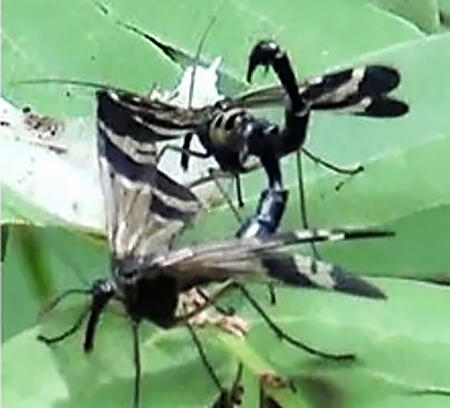Special Educator and Researcher Ryo Ishihara of the Faculty of Agriculture, Okayama University and Professor Takahisa Miyatake of the Graduate School of Environmental and Life Science, Okayama University have discovered that, while male scorpionflies (Panorpa japonica, order Mecoptera) offer females a gift when attempting mating, their mating behavior differs between groups in Aichi and Okayama.

Photo taken and provided by Ryo Ishihara
According to Ishihara, 'During the year before last, when we observed the behavior of Japanese scorpionflies in Okayama, I wondered whether male mating behavior varies by local population, as our results differed from those of past research carried out in Aichi, and so I began this research.'
In a similar fashion to humans, there are species of insects and birds in which males offer gifts to females when courting; these are known as nuptial gifts. The research group have now clarified that among insects (the Japanese scorpionfly), males living in different regions display different mating behaviors in regard to these gifts.
Male scorpionflies compete with each other over gifts for females. In the group living in Aichi, males that lost a male-male competition would immediately give up and search for another gift. However, males in Okayama persisted in focusing on the gift in front of them, even after losing, and would use that gift to call another female to mate with while the winning male was busy copulating.
Moreover, when the group carried out an experiment that involved taking males from both regions to a laboratory and breeding them there, they found that the offspring of each group still displayed the mating behaviors of the wild individuals. The females used in this experiment were a homogenous group, bred over several generations in the laboratory, and so the researchers learned that the different mating methods of the males of each region are passed on to the offspring. In addition, through these experimental results, they were able to show, for the first time in the world, that males from Aichi and Okayama obtain their different mating methods genetically, rather than from their living environment.
Among insects, scorpionflies are a group that retain strong primitive characteristics, and, in a few genera, their ability to fly is weak. This suggested that males have evolved with different behaviors to obtain access to females according to the region in which they live.
Ishihara noted, 'Our aim is to identify the main causes of the variations in alternative mating tactics among males in different regions by investigating the environmental conditions of the regions (the diversity of predators, the atmospheric temperature, etc.), and to clarify how mating behaviors evolved and the start of their evolution by carrying out comparisons of mating behaviors among different species of scorpionfly across different regions.'
Journal Information
Publication: Journal of Ethology
Title: Differences in mating tactics performed by males of two local populations of the Japanese scorpionfly Panorpa japonica
DOI: 10.1007/s10164-022-00753-2
This article has been translated by JST with permission from The Science News Ltd.(https://sci-news.co.jp/). Unauthorized reproduction of the article and photographs is prohibited.




